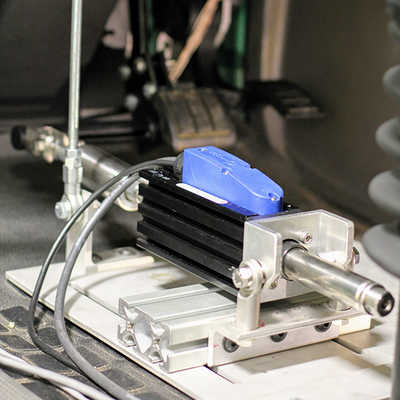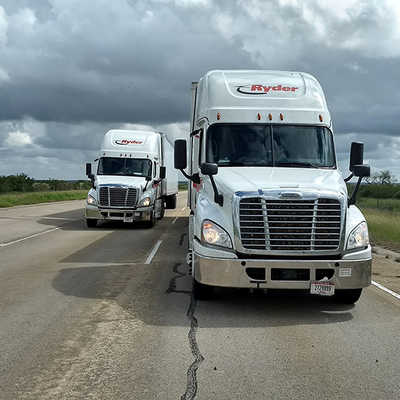Background
SwRI has performed on-road and on-track fuel economy testing for commercial and government clients over the past few decades through Society of Automotive Engineers (SAE) J1321 and J1526 tests. In recent years, the industry has shifted from performing steady-state testing to transient test cycles, as well as attempting to quantify smaller changes in vehicle fuel consumption. The driving precision required to achieve low confidence intervals is an incredibly difficult task in a test that requires two vehicles and two drivers. This project aims to create a semi-autonomous driving solution to increase the precision of on-track fuel economy testing.
Approach
 Figure 1: Brake control is performed by a linear actuator that reproduces the driver’s pedal position
Figure 1: Brake control is performed by a linear actuator that reproduces the driver’s pedal position Drawing on SwRI’s experience in on-track fuel economy testing as well as dynamometer fuel economy testing and vehicle control, a new mobile data acquisition and control system was developed. Route trace software had previously been developed to allow drivers to more easily follow transient cycles and give an indication of vehicle distance travelled. Additionally, Direct Electronic Vehicle Control (DEVCon™) had been developed to perform high precision fuel economy testing on a dynamometer using light-duty and heavy-duty vehicles. Through collaboration, a mobile DEVcon system was developed. DEVCon applies an electronic accelerator pedal position (APP) signal directly to the vehicle's engine control unit (ECU) and eliminates the variation normally introduced by a human driver. Brake control is performed by a linear actuator that reproduces the driver’s pedal position. The system maintains a human driving element by recording the driver’s pedal positions through a cycle but allows the robot to make small corrections for changes in ambient conditions in subsequent runs.
Accomplishments
 Figure 2: This project sought to develop a semi-autonomous driving solution to improve the driving precision for tests requiring two vehicles and two drivers.
Figure 2: This project sought to develop a semi-autonomous driving solution to improve the driving precision for tests requiring two vehicles and two drivers. A universal system capable of being installed in many heavy-duty vehicle applications has been developed. This system is the first of its kind to control brakes in a repeatable manner for fuel consumption testing. In developing the system for on-track testing, the team developed distance integration logic to more accurately measure the distance a vehicle has travelled. Additionally, tuning and logic such as dynamic gain scheduling based on vehicle speed, and distance error correction to account for changes in road grade were developed as part of this project. In a J1321 test the team achieved a 95 percent confidence interval of ± 0.79 percent, allowing for real world fuel economy testing of products with a 1 percent fuel economy improvement.
